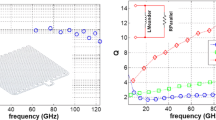Abstract
This paper describes an impedance matching network which allows charge impulses to be measured by a SQUID amplifier with an RMS charge noise of less than 100 e, assuming the SQUID amplifier has a current noise of 2 \(\mathrm{pA}/\sqrt{\mathrm{Hz}}\), and the current pulse has a duration of about 1 μs or shorter. The component values are provided for an example system which has an RMS charge noise of 91 e, assuming all dissipative circuit elements are cooled to a temperature of 100 mK.






Similar content being viewed by others
Notes
The input may be approximated by a delta function as long as its frequency spectrum is nearly constant within the bandwidth of the transfer function, T(ω).
References
T.A. Shutt, A dark matter detector based on the simultaneous measurement of phonons and ionization at 20 mK. Dissertation. University of California, Berkeley (1993)
B.A. Hines, K.M. Sundqvist, D.N. Seitz, M.E. Huber, IEEE Trans. Appl. Supercond. 21, 262 (2011)
Acknowledgements
This work was supported in part by the US Department of Energy under grant number DE-FG02-04ER41295 and by the National Science Foundation under grant number PHY-0801712. Robert Moffatt is also thankful for financial support from The Robert and Marvel Kirby Stanford Graduate Fellowship.
Author information
Authors and Affiliations
Corresponding author
Rights and permissions
About this article
Cite this article
Moffatt, R.A., Cabrera, B., Kadribasic, F. et al. Using SQUIDs to Detect Charge in Cryogenic Germanium Detectors. J Low Temp Phys 167, 638–644 (2012). https://doi.org/10.1007/s10909-012-0593-8
Received:
Accepted:
Published:
Issue Date:
DOI: https://doi.org/10.1007/s10909-012-0593-8




